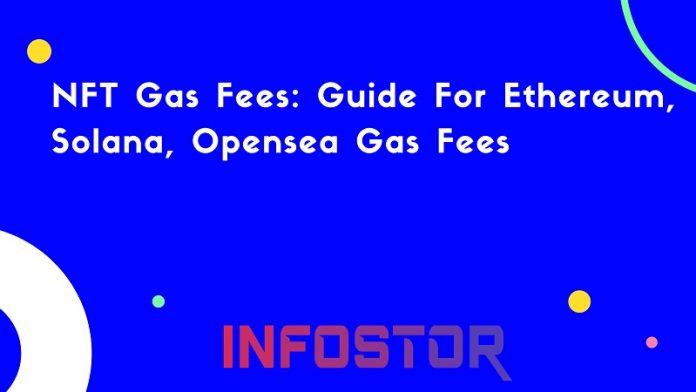Everyone caught in the world of NFTs often stops at this question – ‘what is a Gas Fee for NFT?’ When we mint an NFT on the blockchain, a fee is charged. This fee is called NFT Gas Fees. Most NFT marketplace platforms require upfront payment of the gas fees.
Some, however, have the option of deducting gas fees from the sale price at the end of the transaction. The enthusiasts of NFT must understand the concept of gas fees, why it is levied, and how it is calculated. This has NFT Gas Fees Explained for you.
What Are Gas Fees?
The network uses computing energy and resources while performing any transaction over the respective blockchain network. Gas Fees are the compensation for the energy spent and resources utilized by miners during the transaction. Gas Fees depend on a variety of factors, primarily the complexity of transactions and network traffic. The gas fee rises with the complexity of the transaction. Similarly, the higher the network traffic, the higher the gas fee.
It is similar to the regular road driving experience; the gas/fuel cost is lesser when the roads are perfect, but higher on uneven/dirt roads or off-roads. Similarly, the traffic increases fuel consumption and hence higher costs for the same distance.
What Does NFT Gas Fees Mean? How Are Gas Fees Used To Mint An NFT?
You may wonder why are NFT gas fees so high? The answer lies in the blockchain. Blockchain networks are decentralized. There’s no one individual or organization controlling a blockchain. The concept of blockchain involves several individual blocks, ie, individuals, who help process any transaction. Gas Fees are the way to compensate the individual miners for processing the transaction. NFT Gas fees are also a way to ensure that the blockchain platform isn’t spammed by too many digital assets, and remains a place of value.
The anonymous blockchain miners essentially carry out complex algorithms that ascertain the transaction success on the blockchain. The miners who successfully solve such algorithms are rewarded using the gas fees. Without a fair reward for their time and computing energy, they may not find the task interesting enough.
Additionally, the miners are an important constituent of the blockchain. They help the blockchain stay safe, efficient, and anonymous. The higher the number of miners, the safer the blockchain is. Hence, for the blockchain to function smoothly, it is imperative to have miners, and hence the gas fees.
Why Does NFT Minting Require Gas Fees?
As discussed above, NFT minting uses computing resources and the time of miners on the blockchain. Each transaction on a blockchain network requires NFT Gas Fees. As per the resources available and the demand for resources, the network decides where to allocate its resources. The decentralized network doesn’t have any of the shared computing resources. All the computing resources used are of the miners, and thus gas fees enable the decentralized network to stay decentralized. If it becomes centralized, it will lose all its benefits.
What’s The Cost Of Minting Any NFT?
Let’s consider the cost of minting one NFT on different blockchain networks.
Ethereum NFT Gas Fees
Ethereum Network is the most popular blockchain network on web 3.0. Its popularity has meant that more people consistently use Ethereum over others. The network capacity is limited, and hence the overcrowding happens quite frequently.
NFT Gas Fees Calculator On Ethereum Blockchain
The Ethereum NFT Gas Fees are calculated based on the supply and demand formula. Gas fees are calculated in gwei. 1 Gwei is one-billionth of Ether, the Ethereum native token. Thus, 1 Gwei = 1 nanoether or 0.000000001 Ether. The minimum gas amount needed for a transaction is 21,000.
The Individual NFT Gas Fees Per Transaction equals the Gas Limit multiplied by Gas Price. Since the Gas Limit is 21,000, the total gas fees = 21,000 x Gas Price (in gwei).
The Ethereum Gas is Gas Limit x (Base Price + Tip). Thus, it is 21,000 x (100+10) = 2,310,000 or 0.00231ETH. This equals $7.49 (Taking 1 ETH = $2,971.81).
There’s also a listing fee and account fee apart from this.
There’s an option called lazy minting in Ethereum where the payment can be deferred to the time of sale. The Ethereum gas fee is charged at the time of the transaction. The buyer may pay the gas fees rather than the artist or creator. In the regular option, the NFT creator or artist pays gas fees at the time of the transaction.
NFT Gas Fee On Solana Blockchain Network
Solana Blockchain Network is the second most popular network on web 3.0. Its popularity lies as an alternative to Ethereum that does everything that Ethereum does but at a considerably lower cost. Network congestion doesn’t impact the fees on Solana Blockchain Network. Two approval and one listing transactions take place when one mints an NFT on the blockchain. NFT Gas Fees Calculator for Solana includes a total of three blockchain transactions, with each costing $0.04 (changing as per token value cost) or 0.00045 SOL (Solana Token).
Let’s check how NFT Gas Fees differ on marketplaces like OpenSea and Rarible.
NFT Gas Fees OpenSea MarketPlace For Ethereum Blockchain
OpenSea is the leading marketplace on web 3.0 that is based on Ethereum Blockchain. Before you start listing on OpenSea, a couple of fees are required to be paid. The initialization fee is required to start your account on OpenSea and costs between $70 to $300. The other fee is to authenticate OpenSea to grant access to your NFTs. It costs between $10 to $30. You can find the lowest gas prices through platforms such as GasNow and register when the gas fees are lowest, thus saving considerable cost. You can even check the NFT Gas Fees Chart on any such website.
Do you have to pay a gas fee for every NFT? Not at OpenSea. NFT Gas Fees Opensea doesn’t exist, but OpenSea charges 2.5% of every transaction to the creator once the account is listed and NFT access is granted.
NFT Gas Fees On Rarible
Rarible has a similar option OpenSea. However, Rarible has two additional options. The first one allows you to list your NFT on Flow Blockchain instead of Ethereum. This helps in lowering the gas fees considerably. The second option is free minting (same as lazy minting), where the buyer pays the gas fees. The transaction fee upon every sale is the same as on OpenSea, I.e. 2.5%.
How Are NFT Gas Fees Calculated?
The answer to ‘why are NFT Gas Fees so high?’ lies here. To mint one NFT, the charges depend on the following three costs:
- Gas Fees
- Account Fees
- Listing Fees
Gas fees are used for transactions, and also for storing the NFT on the blockchain. Account fees are NFT marketplace costs and differ for each marketplace. Listing fees are the sales listing charge. To mint an NFT, it can cost from as low as $1 to as high as $500 or even more.
The speed of transaction, along with the time of the day (determining network traffic) and the amount of data for the transaction determine the cost to mint an NFT. It also varies for different blockchain networks, like Ethereum and Solana, and marketplaces like OpenSea and Rarible.
NFTs And Gas Fees: A Gist
NFTs have skyrocketed recently, enticing everyone to start minting their NFTs. Two important considerations, however, are that there are considerable costs involved, and not every NFT gets sold for sky-high prices. In fact, only a few do make the buzz. For a majority of NFT creators, transactions may be in hundreds instead of thousands and above. Our blog has NFT Gas Fees Explained for your perusal and helps you make an informed NFT choice.
This article is published by Infostor.com (c). If you are looking for upcoming NFTs, Check our Upcoming Solana NFTs Page.
Credit: Source link

























 Bitcoin
Bitcoin  Ethereum
Ethereum  Tether
Tether  Solana
Solana  USDC
USDC  Lido Staked Ether
Lido Staked Ether  XRP
XRP  Dogecoin
Dogecoin  Toncoin
Toncoin  Cardano
Cardano  Shiba Inu
Shiba Inu  Avalanche
Avalanche  TRON
TRON  Wrapped Bitcoin
Wrapped Bitcoin  Bitcoin Cash
Bitcoin Cash  Polkadot
Polkadot  Chainlink
Chainlink  NEAR Protocol
NEAR Protocol  Polygon
Polygon  Litecoin
Litecoin  Internet Computer
Internet Computer  Uniswap
Uniswap  LEO Token
LEO Token  Dai
Dai  First Digital USD
First Digital USD  Ethereum Classic
Ethereum Classic  Aptos
Aptos  Cronos
Cronos  Hedera
Hedera  Stacks
Stacks  Mantle
Mantle  Filecoin
Filecoin  Stellar
Stellar  Cosmos Hub
Cosmos Hub  OKB
OKB  XT.com
XT.com  Renzo Restaked ETH
Renzo Restaked ETH  Pepe
Pepe  Immutable
Immutable  Render
Render  Arbitrum
Arbitrum  Wrapped eETH
Wrapped eETH  Bittensor
Bittensor  dogwifhat
dogwifhat  Maker
Maker  Optimism
Optimism  Ethena USDe
Ethena USDe 
